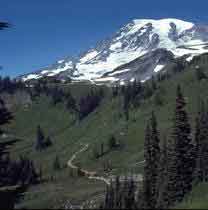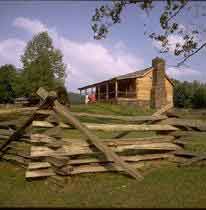VOICE ONE:
Welcome to THIS IS AMERICA in VOA Special English. I'm Steve Ember.
VOICE TWO:
And I'm Shirley Griffith. This week on our program, we look at the subject of a six-part series being shown on public television in the United States. The new film, directed by Ken Burns, is called "The National Parks: America's Best Idea."
(MUSIC)
VOICE ONE:

The United States established its first national park in 1872. Yellowstone, in the western state of Wyoming, was not only the first national park in America. It was the first in the world.
Since then, about 100 nations have followed that example. They have established over 100,000 national parks and protected areas, for the enjoyment of people today and for generations to come.
VOICE TWO:
Last year, almost 275 million people visited the national park system in the United States. Visitors can hike in the woods. Climb mountains. Photograph animals. Explore Civil War battlefields. Go swimming or river-rafting. Ride horses. Or just enjoy a day outdoors with the beauty of nature.
The places under the care of the National Park Service are not all refuges of peace and quiet, however. Some are historic sites in the middle of busy cities.
VOICE ONE:
The National Park Service manages a total of 391 "units," as it calls them. These include national parks, historical sites, monuments, buildings and battlefields. They also include recreation areas, seashores, rivers, trails and parkways. Almost 34 million hectares of land in all.
Rules differ from place to place. For example, activities like hunting are not permitted in national parks. But they may be permitted in areas established as national preserves, recreation areas, seashores or lakeshores.
VOICE TWO:
The National Park Service was created in 1916. President Woodrow Wilson signed an act making it part of the Interior Department.
The act said the purpose was to "conserve the scenery and the natural and historic objects and the wild life therein and to provide for the enjoyment of the same in such manner and by such means as will leave them unimpaired for the enjoyment of future generations."
Congress has the power to establish national parks and other protected areas. But a law called the Antiquities Act gives presidents the power to declare national monuments.
VOICE ONE:

An early champion of the national parks was Theodore Roosevelt. He was president at the start of the 20th century. He was also a distant relation of Franklin Roosevelt, who became president later.
Teddy Roosevelt was a hunter and outdoorsman. As president he signed legislation that established five national parks. And in 1906 he signed the Antiquities Act.
It gave presidents the power to declare federally owned landmarks, structures and "other objects of historic or scientific interest" as national monuments. Teddy Roosevelt himself declared 18 national monuments. Many of the monuments declared by presidents have been named national parks or given other titles by Congress.
(MUSIC)
VOICE TWO:
The National Park Service has two main jobs. One is to protect the national parks. The other is to help visitors enjoy them. Sometimes these two jobs may seem to conflict. For example, large numbers of visitors can mean large numbers of vehicles that cause pollution and road damage.
Spokesman Jeffrey Olson says the Park Service is taking steps to reduce environmental damage. He points out that some parks operate bus systems so visitors do not drive through protected areas.
This also results in a better visitor experience, he says. People do not have to worry about their vehicles. And those who would have been driving can look at the scenery instead of the road.
VOICE ONE:
But the Park Service does not have control over everything. Jeffrey Olson says climate change is changing the landscape. For example, he says glaciers are melting in Alaska as a result of higher temperatures. And animals that normally live in some national parks have had to search elsewhere for food.

Plants, too, are affected. Some areas of Joshua Tree National Park in California, for example, can no longer support the trees that the park is named for.
Jeffrey Olson says experts do not know what will take the place of the plants and animals that are lost, or how wildlife will survive in a changed environment.
VOICE TWO:
For the Park Service, another problem has been money. But Congress has put more into the budget of the national park system in the past three years. That has made it possible for the Park Service to hire 3000 more seasonal workers. And Jeffrey Olson says federal stimulus money this year has made it possible to fix roads and complete maintenance projects.
Money also comes from the National Park Foundation. Congress established the foundation in 1967 to raise private support for the park system.
VOICE ONE:
Some national parks charge visitors a small entrance fee, from 5 dollars to 25 dollars a car. Each entrance fee is good for seven days. 80 percent of the money stays with the park. 20 percent is put into a shared fund for use throughout the park system.

The first park to charge a visitor fee was Mount Rainier in the northwestern state of Washington in 1908. It was also the first park where visitors could enter with their cars.
(MUSIC)
VOICE TWO:
Today the United States has 58 national parks.
Celebrating its 100th anniversary this year is Zion National Park, in the western state of Utah. It was established as Mukuntuweap National Monument by President William Taft.
Zion National Park has desert canyons and huge freestanding arches of red, pink and white rock. It also has a river, forests and other environments.
Zion is the eighth most visited national park. Almost three million people visited the park last year. Buses take visitors to areas where they can go on paths into the wilderness.
VOICE ONE:
One easy hike takes visitors two kilometers to a clear pool of water and waterfalls. A more difficult hike is eight kilometers long and not for those afraid of heights. It ends at the top of a rock high above Zion Canyon.
One of the largest mountains in the park is called the Sentinel. Three mountains standing next to each other are called the Three Patriarchs -- Abraham, Isaac and Jacob. A visiting Christian minister gave the mountains these biblical names in 1916.
(MUSIC)
VOICE TWO:

The Great Smoky Mountains National Park is celebrating its 75th anniversary this year. The park is located in areas of two southeastern states, Tennessee and North Carolina. The Great Smoky Mountains National Park is America's most visited national park. More than nine million people went there last year.
The Great Smoky Mountains are part of the Blue Ridge and southern Appalachian mountains. A blue-gray haze from natural and now manmade sources hangs over them like smoke.
The park has more than 1000 kilometers of trails. Visitors can camp, fish, ride bicycles or drive through the park. There are more than 1600 kinds of flowering plants. The Park Service says the park has more kinds of flowering plants than any other national park in North America.
It also has animals including deer, elk and more than 1500 bears.
VOICE ONE:
The Great Smoky Mountains National Park was created by local citizens who wanted to protect the area. But they needed money to buy the land from farmers and other owners. The money came from the legislatures of Tennessee and North Carolina. It also came from individuals and groups including the Laura Spellman Rockefeller Foundation.
In 1934, Tennessee and North Carolina gave the federal government more than 300,000 hectares of land for the park.
The official dedication did not take place until 1940, when President Franklin Roosevelt spoke at a ceremony in the park. The ceremony took place at the Rockefeller Monument, on the borderline between the two states that provided the land.
Earlier this month, officials rededicated the park at a ceremony held on that same spot. One of the guests was Dolly Parton. The country singer grew up in the Great Smoky Mountains, and wrote a fund-raising CD for the 75th anniversary. We leave you with Dolly Parton and a song called "My Mountains, My Home."
(MUSIC)
VOICE TWO:
Our program was written by Nancy Steinbach and produced by Caty Weaver. I'm Shirley Griffith.
VOICE ONE:
And I'm Steve Ember. For links to national park Web sites, and for transcripts and podcasts of our programs, go to voaspecialenglish.com. Join us again next week for THIS IS AMERICA.
elk: large northern deer with enormous flattened antlers in the male 驼鹿
Related stories:
Visiting four national parks in western US
Visiting 7 man-made wonders in the US
Yosemite: one of the most famous national parks
Camping in America's national and state parks
(Source: VOA 英语点津编辑)